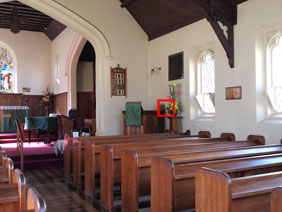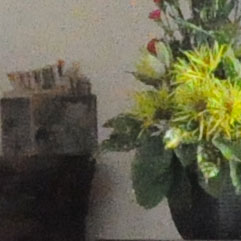Olympus PEN E-P1
-
-
Written by Gordon Laing
Olympus E-P1 vs Panasonic Lumix DMC-FZ35 / FZ38 vs Nikon D90 High ISO noise
|
 | To compare noise levels under real-life conditions we shot this scene with the Olympus E-P1, Panasonic Lumix DMC-FZ35 / FZ38 and the Nikon D90 within a few moments of each other using each of their ISO settings. This allows us to compare the E-P1 against a popular compact and DSLR, each featuring 12 Megapixels. The lenses on each camera were adjusted to deliver the same vertical field of view. |
Note: see how the E-P1 compares against the Panasonic GF1 and Canon G11 here.
The image above was taken with the Olympus E-P1 in Aperture Priority mode at 19mm f5.6 with a sensitivity of 100 ISO. The original JPEG measured 5.24MB and the metered exposure was 0.62 seconds. As expected, the exposure halved each time the sensitivity was doubled. The crops are taken from the area marked with the red square and presented below at 100%.
We used the default noise reduction settings for each camera, and any contrast adjustment options were disabled as they can artificially increase visible noise levels. As such, Active D-Lighting on the Nikon was disabled and the E-P1’s Gradation set to Normal. Note the Nikon D90 captures wider 3:2 aspect ratio images, so by matching the vertical field of view, we’re effectively treating the DSLR here as a 10.8 Megapixel camera, delivering 4:3 shaped images.
The Olympus E-P1 delivers clean and detailed results between 100 and 400 ISO. Faint noise textures may be visible in the crops below from 200 ISO upwards, but they’re certainly nothing to worry about at this point.
Alongside the E-P1 crops you can see how a ‘compact’ camera with a small sensor compares, and the difference is clear. The Panasonic FZ35 / FZ38 suffers from visible noise throughout its entire range, and 200 ISO is about as high as you’d want to use it for the best results.
Moving onto the Nikon D90’s crops though, and you’ll see its images are essentially bereft of any noise textures from 100 to 400 ISO, giving it the preferred result of the three cameras here. Sure the D90 costs much more, but the cheaper D5000 shares the same quality at a price closer to the Olympus.
To be fair though, the E-P1’s image processing using the default settings isn’t doing it any favours here. As seen on our first results page, the E-P1 is applying much greater sharpening and contrast than the other two cameras here, and this in turn is making any subtle noise textures much more obvious. Tone down the settings or adjust the noise reduction and you can achieve cleaner-looking results at higher sensitivities.
That said, returning to the crops below, the E-P1 takes a noticeable turn for the worse at 800 ISO, with a softer overall appearance and a loss of fine detail. The Nikon D90 is still holding it together better at this point, while the FZ35 / FZ38 is unsurprisingly suffering the most.
At 1600 ISO the E-P1 suffers from more visible noise artefacts than before and is noticeably worse than the D90, although it’s a world-apart from the FZ35 / FZ38. With the sensitivity increased to 3200 ISO, noise has become quite obtrusive on the E-P1, whereas the D90 remains comparatively clean. At this point, the FZ35 / FZ38 switches to its High Sensitivity preset, operating between 1600 and 6400 IS) at a greatly reduced resolution. The camera automatically selects the ISO in this range, although none look particularly good.
Finally, we have the E-P1 and D90 at 6400 ISO, still operating at full resolution. The Nikon has certainly become noisier than before, but there’s no contest: it delivers a much preferable result to the E-P1.
In terms of comparing sensor real-estate, this isn’t a surprising result overall. The Olympus E-P1 may not keep-up with the D90 at 800 ISO and above (at least using JPEGs and default settings anyway), but it’s considerably better than a camera with a compact sensor like the FZ35 / FZ38. It’s also better than the only other compact camera we’ve tested with a DSLR-sized sensor, the Sigma DP1.
We plan to compare the E-P1 against the Panasonic Lumix GF1 in the future, but in the meantime it delivers the best quality we’ve seen from a small camera – but like other models which use a Four Thirds sensor, just don’t expect it to keep up with the best APS-C DSLRs on the market. This is a camera which is happiest operating below 800 ISO.
Now head over to our Olympus E-P1 Gallery to see some more real-life shots in a variety of conditions.
Olympus E-P1 with M.Zuiko Digital 14-42mm |
Panasonic Lumix DMC-FZ35 / FZ38 |
Nikon D90 with Nikkor DX 18-105mm VR | ||
 |  |  | ||
80 ISO not available |
80 ISO |
80 ISO not available | ||
 |  |  | ||
100 ISO |
100 ISO |
100 ISO | ||
 |  |  | ||
200 ISO |
200 ISO |
200 ISO | ||
 |  |  | ||
400 ISO |
400 ISO |
400 ISO | ||
 |  |  | ||
800 ISO |
800 ISO |
800 ISO | ||
 |  |  | ||
1600 ISO |
1600 ISO |
1600 ISO | ||
 |  |  | ||
3200 ISO |
3200 ISO |
3200 ISO | ||
 |  |  | ||
6400 ISO |
6400 ISO not tested |
6400 ISO |





